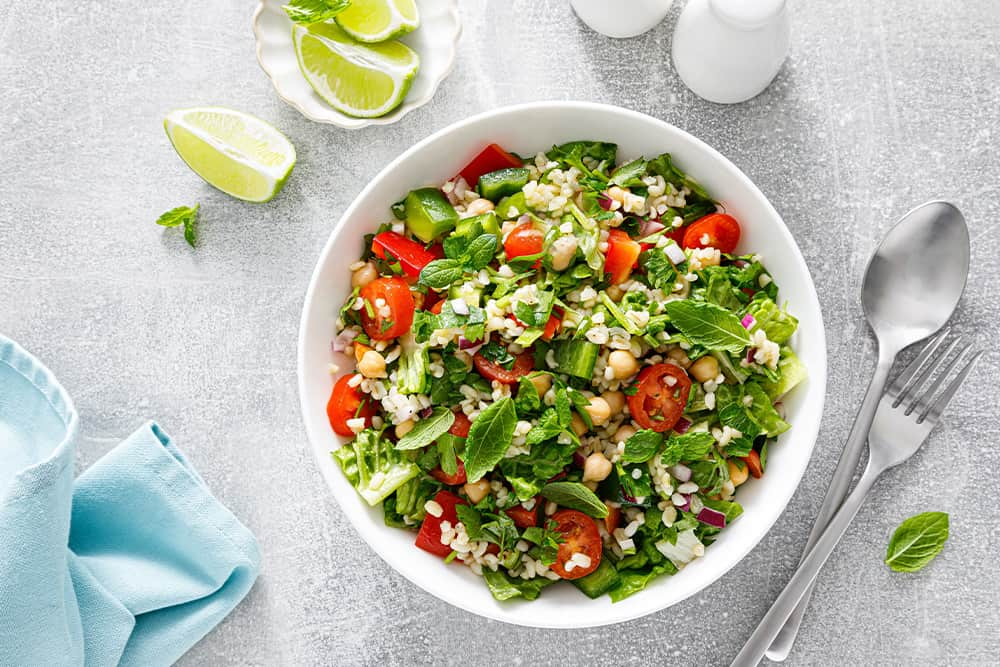Do you have high cholesterol? Or have you been told to watch your cholesterol level? You might wonder what steps to take. Eat healthier, maybe more veggies? Exercise more? Limit calories? So many questions!
I hope to help provide a little direction to help you.
What Is Cholesterol?
Let’s start with a little bit about cholesterol first. Cholesterol is a molecule made by the liver. It is a part of the lining of each of our cells and helps with hormone and vitamin D metabolism.
Our liver makes all the cholesterol we need so we don’t need to get cholesterol from our diet or the environment. We refer to it as a non-essential dietary nutrient. For this reason, our intake amount is a recommended daily allowance.
What Are Cholesterol Intake Recommendations?
The American Heart Association recommends less than 100 mg of cholesterol per day if your cholesterol levels are normal. If your cholesterol levels are abnormal, the American Heart Association refers you to your doctor. In that situation, our quickest answer is usually to try a medication or to tell you to eat healthier. While there are certain conditions where cholesterol medications are necessary, there are just as many times where modifying your diet is the first recommendation.
Often addressing dietary intake can be a long-term solution to lowering cholesterol. It can also help avoid medications. Even if you and your doctor decide that a medication would be helpful, diet changes to lower your cholesterol intake will also help your condition.
What Are Safe or Normal Cholesterol Levels?
When we talk about cholesterol levels, we measure several different components. The low-density lipoproteins (LDL) are usually what are directly related to cardiovascular risk. For this reason, LDL is sometimes called the ‘bad’ cholesterol. Sometimes we will look at other components of the lipid panel, but overall, getting LDL to the goal level is the focus. This also helps determine dietary recommendations and medication management.
The American Heart Association and the American College of Cardiology help set lipid panel guidelines. A lipid panel is a blood test that measures your cholesterol and triglyceride levels.
Here are the recommended levels for optimal health:
- Total cholesterol: Less than 200 mg/dL
- LDL: Less than 70 mg/dL
- HDL: Greater than 45 mg/dL in women and greater than 50 mg/dL in men
- Triglycerides: Less than 150 mg/dL
There are a lot of factors that go into your cholesterol levels, but one of the biggest is diet. Cholesterol levels are directly related to how much cholesterol you eat, even if high cholesterol runs in your family genetics.
How Can You Use Your Diet to Lower Cholesterol?
My first recommendation is to pay attention to how much cholesterol you are actually eating. Thankfully, a food’s cholesterol content is listed on the nutrition panel. Simply flip the package over, find the nutrition panel and the cholesterol content is listed there. We care about the milligrams of cholesterol as opposed to the percentage. Please also pay attention to the portion size as this will be how much cholesterol is in a specific portion size of that food. Your cholesterol intake throughout the day should be less than 100 mg.
Which Foods Contain Cholesterol?
Anything that has a liver to produce cholesterol will have cholesterol in it or its products. So, any kind of meat or animal product will have cholesterol in it; how much is entirely dependent on the product. That’s why it is important for you to look at the nutrition panel. Some foods are very high in cholesterol, such as eggs. One egg has anywhere from 220 to 250 mg of cholesterol. That’s over two days’ worth of cholesterol intake! However, other animal products such as skim milk won’t have as much cholesterol.
So, to reduce your cholesterol intake, it is going to mean eating a more plant-based diet. Foods that come from plants do not contain cholesterol because there’s no liver to create the cholesterol. However, it is important to note that we don’t want a highly processed plant-based diet. (Oreos are technically vegan.)
What About Protein in a Plant-Based Diet?
The next question my patients normally ask is, “What am I going to eat for protein?” A well planned, well balanced plant-based diet will get you enough protein. I will talk about protein requirements in a future blog, but just know that you can get plenty of protein through a plant-based diet.
There are a lot of plant-based protein alternatives. The key is to try to make it as unprocessed as possible. That is where your whole grains, legumes, beans, nuts and seeds come in. Meat alternatives (veggie meats) are a good option for those special occasions where we typically eat meat.
Some of the most common and highest protein containing plant products are:
- Edamame
- Tofu
- Lentils (Did you know there are 5 different colors of them?!)
- Beans
- Peas
- Tempeh
- Seitan
- Quinoa
- Millet
- Hemp
With a little bit of research, these are easy foods to learn how to cook and make tasty. There are tons of recipes online that can help with this.
7 Tips to Lower Your Cholesterol
- Pay attention to how much cholesterol you eat each day.
- Work on limiting cholesterol intake to less than 100 mg per day; if your cholesterol level is already high, make your intake even lower or eliminate cholesterol.
- Follow a more whole food (unprocessed), plant-based diet.
- Try a meatless Monday. Or a meatless Monday, Wednesday and Friday! Or a meatless week!
- Remember, it is not just meat that contains cholesterol, but also animal products like eggs.
- Work with your doctor to monitor your cholesterol levels as you make some of these changes so you know how much cholesterol your body can actually handle.
- Remember that cholesterol is made by our body and therefore it is not something we are required to eat.
- Remember that sometimes cholesterol medications are still recommended for certain conditions even if your cholesterol levels are normal. If your doctor is recommending this, make sure you understand why they want you on a cholesterol medication.

Dr. Crista Few
Family Physician, Bryan Primary Care









